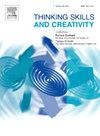语言学习课堂中的创造性思维:摩洛哥公立小学教育政策分析
IF 4.5
2区 教育学
Q1 Social Sciences
引用次数: 0
摘要
创造性思维被认为是21世纪的基本技能之一,应该在整个教育系统中得到促进,特别是在小学的所有学科中,包括语言课。在学校有效发展创造性思维的第一步是提供一个课程,明确指导如何培养这种技能。教育政策文件至关重要,因为它们概述了课堂上应传达的内容和过程。本文报告了对摩洛哥五份教育政策文件的分析结果,即《国家教育和培训宪章》(1999年)、《白皮书》(2002年)、《2015-2030年战略愿景》、《框架法51-17》(2019年)和《小学教育课程》(2021年)。分析集中在两个关键问题上:摩洛哥教育政策文件如何定义和描述创造性思维,以及如何阐明整合这一技能的重要性,特别是在语言学习课程中。我们的分析表明,教育政策文件并没有对创造力给出一个清晰的、可操作的定义,而且这个术语在各个学校学科的使用也不同。所提供的技能描述都是积极的,这表明它没有被视为消极属性。然而,这些文件并没有就教师应该如何培养创造性思维提供指导。此外,教育政策文件经常将创造力等同于艺术生产。这表明,在考虑促进创造性思维的活动时,教育政策制定者有一种偏见或偏好,主要是考虑艺术作品。最后,本研究为政策制定者提供了切实可行的建议,以通过教育政策文件有效地将促进创造性思维纳入语言教育。本文章由计算机程序翻译,如有差异,请以英文原文为准。
Creative thinking in language learning classes: An analysis of educational policy in Moroccan public primary schools
Creative thinking is considered one of the essential skills of the 21st century that should be promoted throughout the educational system, particularly in primary schools across all subjects, including language classes. The first step in effectively developing creative thinking in schools is to provide a curriculum with clear guidelines on how to foster this skill. Educational policy documents are of paramount importance because they outline the content and processes that should be communicated in the classroom. The current article reports the findings of an analysis of five Moroccan educational policy documents namely, The National Charter for Education and Training (1999), The White Paper (2002), The Strategic Vision of 2015–2030, The Framework Law 51–17 (2019), and The Primary Education Curriculum (2021). The analysis centers on two key questions: how creative thinking is defined and described in Moroccan educational policy documents, and how the importance of integrating this skill is articulated, particularly in the context of language learning classes. Our analysis reveals that educational policy documents do not offer a clear and operational definition of creativity, and the term is used differently across school subjects. The provided descriptions of the skill are all positive, suggesting that it is not perceived as a negative attribute. However, the documents do not offer guidance on how teachers should develop creative thinking. Additionally, educational policy documents often equate creativity with artistic production. This suggests that educational policy makers have a bias or preference for thinking mainly about artistic work when considering activities that promote creative thinking. The study concludes with practical recommendations for policymakers to effectively integrate the promotion of creative thinking in language education through educational policy documents.
求助全文
通过发布文献求助,成功后即可免费获取论文全文。
去求助
来源期刊

Thinking Skills and Creativity
EDUCATION & EDUCATIONAL RESEARCH-
CiteScore
6.40
自引率
16.20%
发文量
172
审稿时长
76 days
期刊介绍:
Thinking Skills and Creativity is a new journal providing a peer-reviewed forum for communication and debate for the community of researchers interested in teaching for thinking and creativity. Papers may represent a variety of theoretical perspectives and methodological approaches and may relate to any age level in a diversity of settings: formal and informal, education and work-based.
 求助内容:
求助内容: 应助结果提醒方式:
应助结果提醒方式:


